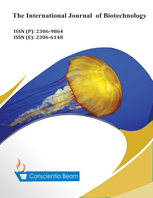Evaluation of In-Vitro Anti-Bacterial Qualities of Camels Urine in Somali Region of Ethiopia against Selected Bacterial Pathogens
DOI:
https://doi.org/10.18488/journal.57.2021.101.1.14Abstract
Camel urine is believed to contain therapeutic and anti-bacterial factors. Until recently, there is no relevant study done to assess the antibacterial qualities of camel’s urine in Somali regional state, Ethiopia. The aim of this study was to evaluate the anti-bacterial activity of camel urine against some selected bacterial in the region. A laboratory based experimental research was conducted in Jigjiga University, Ethiopia. 13 samples of camel’s urine were collected in the Morning during April, 2020, of which 7(56.8%) were female camels and 6(43.2%) were male camels and the anti-bacterial potency of camel urine against some pathogenic bacterial including Klebsella Pneumonia, Citrobacter, Escherichia Coli, and Staphylococcus aureus were tested. Then, Minimum inhibitory concentrations and Minimum bactericidal concentrations values were figured out accordingly. Data were analyzed SPSS Version 23. Mean inhibition zone of Klebsella Pneumonia (18.631 ) Citrobacter (16.83 1.39) Escherichia Coli (14.73 ), and Staphylococcus aureus (10.66 ) were founded in the study and mean minimum inhibitory concentration of Klebsella Pneumonia (12.02%,) Citrobacter (8.2%), Escherichia Coli (12.5%), and Staphylococcus aureus (10.6%) and also the result indicated a mean minimum bactericidal concentration of Klebsella Pneumonia (9.6%), Citrobacter (9.1%), Escherichia Coli (9, 6%), and Staphylococcus aureus (10.1%). The result showed potential antibacterial effects of camel (Camelus dromedarius) urine against bacterial strains tested on. Therefore, camel urine could be used as an ingredient that can be produced antibiotics to prevail against any of the illnesses caused by the bacterial species tested on it.

